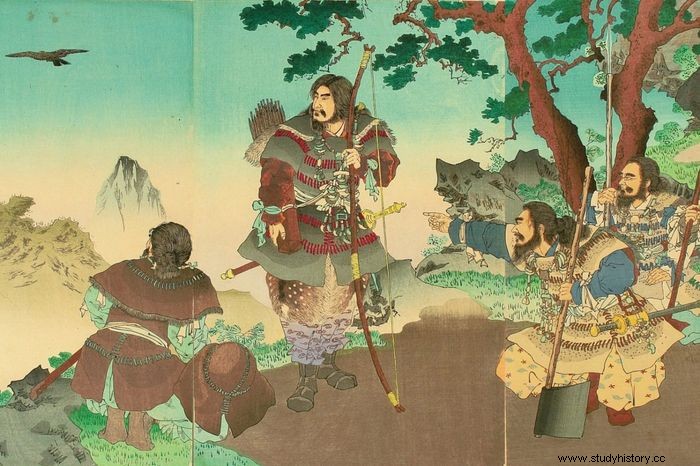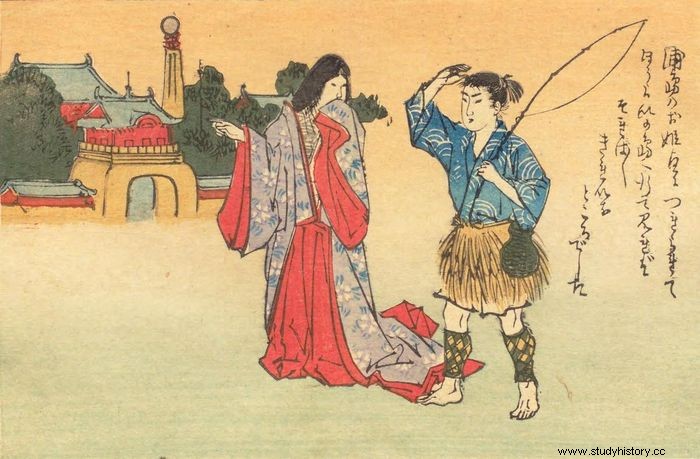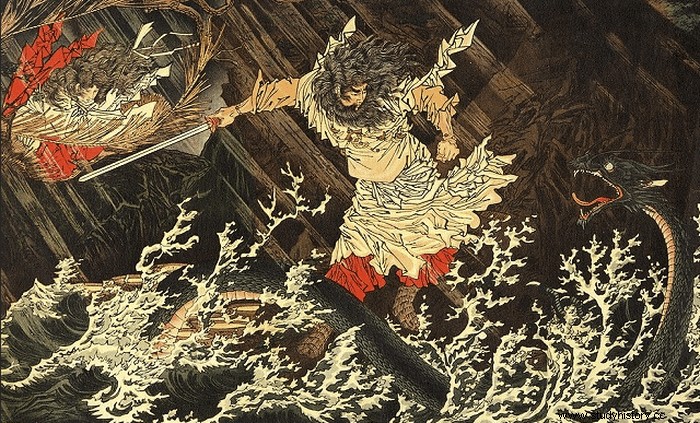Japanese mythology is rich in epic fairy tales and serious philosophical foundations. Learning about Japanese history and culture is also a good idea.
Japanese mythology is made up of stories based on traditional folk beliefs, and it combines parts of Shinto mythology and Buddhism. Several ancient stories have been inherited over the centuries both through spoken word and writing. These stories cover almost every area of life. Deities, monarchy and nature are common motifs in Japanese mythology. In Japanese mythology, gods and goddesses are popular as kami, and many of them! With such a wide variety of personalities, it is no surprise that Japanese culture has so many exciting stories woven through it. We have selected five of the most famous ancient Japanese myths and stories so you can experience their amazing beauty!

Japanese creation myth
The original floor is based on Kojiki's Record of Ancient Matters, Japan's earliest book and Nihon Shoki. The story begins in the dark, quiet, endless chaos of the universe. Then particles begin to move and produce sound after many millennia. Finally, the sky appeared when the lightest particles rise to construct the sky when the first three gods - the three creative gods - appear.
The remaining particles fall to the ground and form a mass known as the "Earth", but it takes millions of years to solidify. Two other deities appear immediately, this time on earth, springing from a reed. Many more gods appear, but they serve no other purpose than to exist while the cosmos continues in turmoil. Finally, Izanagi and Izanami, two gods, are called and commanded to go down to the ground to preside over creation. As a result, life on earth began.
The sun, the moon and the wind
The Japanese mythology character Izanami dies during birth shortly after birth. Izanagi, in despair, travels to Yomi, the home of the dead, to bring her back. But Izanagi is too late. Izanami's body has already begun to decay. So when Izanagi goes down to earth to purify himself, other deities arise, including Amaterasu, the sun goddess, Tsukuyomi, the moon god, and Susanoo, the wind god.
Amaterasu and the Cave
Amaterasu is the most famous Japanese deity, and her rivalry with her brother SusanO-O is central to Japanese mythology. After another confrontation with SusanO-O, Amaterasu retires to the most famous floor cave. As a result, the world plunged into severe darkness, and terrible spirits roamed the earth.
The gods finally lure her out of the cave when Ame-No-Uzume, the goddess of joy, dresses in flowers and dances on an inverted sink. The male gods laugh hysterically as the flowers fall from her body. Then, finally, Amenotejikara pulls Amaterasu from the cave as she peeks out, and the light returns to the world. In Japan today, this Shinto-mythological tale is often recalled through theatrical performances.
Hare of Inaba
The history of Japanese mythology has two versions. Let's focus on the most popular. This ancient Japanese fable is a metaphor for how civilization fought against savagery to become the land of Japan. The story goes that a hare tricks a crocodile into making a bridge so he can go to an island. Unfortunately, the crocodiles find the trick and team up to strip all the hare's fur. At the same time, a few people who look familiar as the king's son pass the hare. The hare shouts at them and asks for help. The brothers recommend that the hare wash in seawater and dry in the sun.
Unfortunately, the salt from the salt water makes the hare even more uncomfortable, and the hare cries out in pain while lying in the field. Soon another brother instructs the hare to swim in clean water and roll in the cattail pollen. After the cure, the hare compensates his brother, the fairy Okuni-nushi-no-Mikoto, after telling him that he wants to marry Princess Yakami. The Inaba hare is honored for bringing modern Japan to life through his portrayal of festivals, works of art and temples. It's one of Japan's most famous stories.

Emperor Jimmu
Jimmu, the great-granddaughter of the goddess Amaterasu, is Japan's mythological creator and the country's first ruler, according to traditional traditions. According to legends, he was born in 711 BC. and died in 585 BC, making him 126 years old at the time of his death. Lack of evidence, however, obscures Jimmus' existence. In fact, current experts believe that Suizei, Jimmus' successor, was the only one of the nine emperors who survived. Despite this actual inconsistency, this ancient Japanese mythology remains significant because it tells the story of how the imperial family, which still exists today, came into being.
Kintarō
Kintaro, a young boy of exceptional strength, was cared for on Mount Ashigara by a mountain witch. He developed friends with mountain animals and then became Sakata no Kintoki, a warrior and devoted disciple of Minamoto no Yorimitsu. It is a Japanese custom to show a Kintar doll on boys' day, in the hope that the boys of the family would be just as brave and powerful.
Momotaro
His name translates technically as Peach Tar; because Tar is a common Japanese boy's name, it translates to Peach Boy. Momotar is also the title of several novels, films and popular works that depict this hero's story. According to the current version of the story (dating from the Edo period), Momotar arrived on Earth inside a giant peach that was discovered floating down a river by an elderly, childless lady washing laundry. When her mother and husband tried to open the peach to eat it, they discovered the baby. The boy said that heaven had sent him to be their son.
The couple called him Momotar, a combination of momo (peach) and tar (dog) (eldest son in the family). Years later, Momotar left his parents to go to the island of "Onigashima" to eliminate the roaming onies (demons or trolls) who lived there. Momotar met and became friends with a talking dog, monkey and pheasant along the way, who volunteered to help him in his mission. Eventually, Momotar and his animal companions infiltrated the demon fort on the island and forced the demon commander, Ura, and his army to surrender. After that, Momotar went home with his new friends, and his family lived happily ever after.

Urashima Tarō
Urashima Taro was fishing one day when he came across a turtle that appeared to be in distress. He carefully rescued the turtle, and when I returned, the turtle took Urashima to the Dragon Palace, far below the sea. Urashima met a charming princess there and spent a few days underwater (with the gills bestowed by the magic of the turtles).
However, he was not aware that time passed considerably slower in the Dragon Palace than on land, and that three hundred years had passed on land during the few days under water. When Urashima expressed a desire to return to dry land, the princess gave him a box that kept his real age, but did not reveal what was inside. She forbade him to open the box. When he returned home, he saw that his whole family had died. Grieving, he opened the box and let out a cloud of white smoke that made Urashima grow old and die.
Issun-Bōshi
An elderly couple lived alone and without children. Despite her advanced age, the elderly mother longed to have a child, even though he was only one inch tall. The elderly woman's request came true. Issun-bshi was the name given to the little one (One-Inch Boy). Despite his minimal size, the boy was well taken care of by his parents. However, one day the young boy discovered that he would never be taller than an inch and set out on a long journey to discover his place in the world.
Issun-bshi, who saw himself as a little warrior, got a sewing needle for a sword, a rice bowl water scooter and chopsticks for oars. He floated down the river to the capital, where he applied for a position with the government. Issun-bshi then visited the house of a wealthy daimyo, the daughter of a beautiful princess. He met scorn for his small stature there, but he was still commissioned to escort the princess as her companion. They traveled together when they were abruptly received by an Oni (or a troll in some translations). The young boy used his needle to defeat the monster, and Oni dropped the magical Mallet of Luck. The princess used the power of the hammer to enlarge him to full size as a prize for his bravery. Issun-bshi and the princess became close friends and eventually married.

Bunbuku Chagama
In Japanese mythology, "Bunbuku Chagama" is translated as "happiness that bursts like a teapot." The story is about a poor guy who discovers a tanuki (raccoon dog) trapped in a trap. He released the animal since he felt terrible about it. That evening, tanuki visited the poor man's home to express his gratitude for his generosity. Tanuki turned into a chagama and instructed the guy to sell him for money.
The merchant sold the tanuki teapot to a monk, who carried it home and boiled water in it after cleaning it vigorously. Unable to withstand the heat, the Tanuki teapot developed legs and fled in its semi-transformed state. Tanuki came back to the poor guy with a new plan. The man set up a "road attraction" (a small circus-like setup) and paid entrance to see a teapot go on tight wire. The scheme succeeded, and both parties benefited:the guy was no longer poor, and the tanuki found a new friend and a home.
Hanasaka Jiisan
The legend of the older man who made the flowers bloom. An elderly couple without children loved their dog. It was digging in the garden one day and discovered a box of gold coins. A neighbor assumed that the dog could uncover treasures and arranged to borrow the dog. Unfortunately, the dog only found bones when it dug in his yard, so he killed it. He informed the couple that the dog was dead. They cried and buried it under the fig tree where they had discovered the wealth.
One night the dog's master dreamed that the dog ordered him to cut down the tree, make a mortar out of it and beat rice in the mortar. He told his wife, who told him they had to do what the dog suggested. When they did, the rice in the mortar was turned into gold. A neighbor borrowed the mortar, but his rice turned into foul-smelling berries, so he and his wife smashed and burned it.
That night, the dog commanded his master in a dream to take the ashes and sprinkle it on certain cherry trees. As he did so, the cherry trees blossomed, and the passing daimyo (feudal lord) astonished and filled him with gifts. The neighbor tried in the same way, but his ashes blew into Daimyo's eyes, so he put him in jail; after he was released, his village would not allow him to live there again, and he could not find a new home with his dirty ways.
Susanoo and Orochi
The Japanese mythology character Susanoo, who had been expelled from heaven, arrived in Izumo province (now part of Shimane Prefecture). It did not take long before he came to an elderly father and his wife, crying for their daughter. The elderly couple said they had eight daughters who were consumed one by one each year by the dragon Yamata-no-Orochi (eight-forked snake). The frightening dragon had eight heads and eight tails, spread over eight hills, eyes had the color of fine wine. Kusinada, or Kushinada-Hime was the eighth and last daughter.
Susanoo immediately recognized the ancient couple's connection to the sun goddess Amaterasu and offered his help in exchange for their beautiful daughter's hand in the marriage. Susanoo turned Kushinada into a comb and gently hid her in his hair after her parents agreed. He also erected a massive fence-like barrier around the home, eight gates opened in the fence, eight tables set at each gate, and eight barrels loaded with eight times brewed rice wine placed on each table. Orochi came and found his way blocked; despite boasting of his power, he could not pass the barrier. His excellent sense of smell discovered the guilt, which Orochi adored, and the eight heads were taken by surprise. They wanted to sip the wonderful sake that waved to them, but the gate stood in their way and prevented them from getting there.

Susanoo and Orochi
One person advised to break the barricade. But to do so would overturn the blame and throw it away. Another suggestion was to combine their flaming breath and burn the fence to ashes, but the guilt would evaporate. The heads began to look for an opening and discovered the hatches. They were eager to push their heads through the hole and sip sake. The smartest head, the eighth, informed his colleagues about the stupidity of something like this and offered to go through first to make sure everything was in order. Susanoo waited his turn, letting his head drink a little sake in safety and reporting to the others that there was no risk.
Finally, each of the eight heads went through one door and drank every last drop of sake in the barrels. Susanoo unleashed his attack on Orochi as soon as his heads finished drinking. The big snake, intoxicated by so much sake, was no match for the crazy Susanoo, who beheaded each head in turn and slaughtered Orochi. A nearby river turned red from the blood of the defeated serpent. Susanoo discovered a beautiful blade from the dragon's tail that his sword had not been able to cut when he cut the monster into pieces. The sword eventually went to Amaterasu. He was named Ame no Murakumo no Tsurugi (or Kusanagi).
the conclusion
An important component of Japanese mythology is that it gave a history of origin to Japan and credited divine origins to the Japanese imperial line, giving them the deity. Mythology is mysterious, and mysterious Japan contributes to the enchantment!
